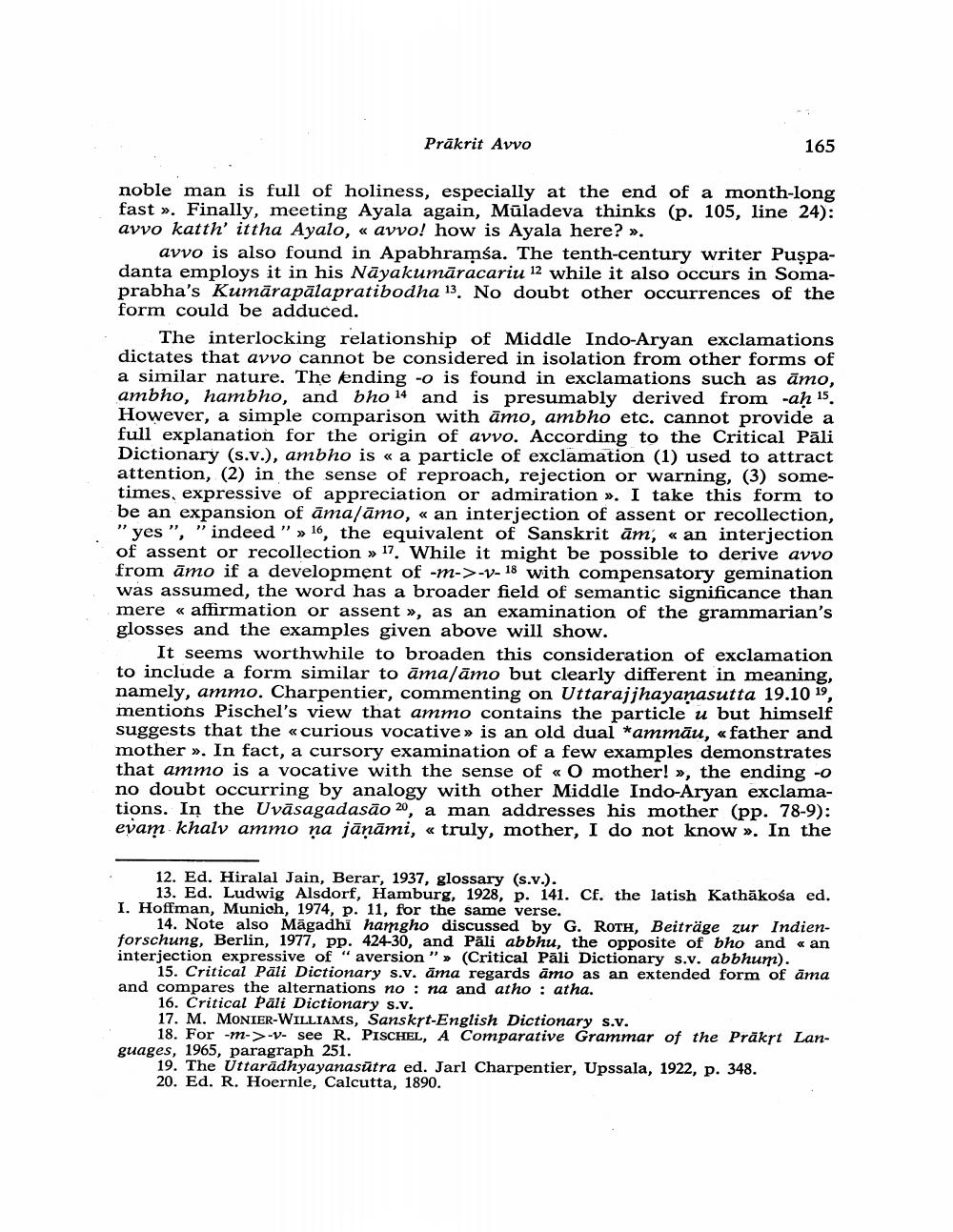________________
Prākrit Avvo
165
noble man is full of holiness, especially at the end of a month-long fast ». Finally, meeting Ayala again, Müladeva thinks (p. 105, line 24): avvo katth' ittha Ayalo, « avvo! how is Ayala here?».
avvo is also found in Apabhramśa. The tenth-century writer Puşpadanta employs it in his Nāyakumāracariu 12 while it also occurs in Somaprabha's Kumārapālapratibodha 13. No doubt other occurrences of the form could be adduced.
The interlocking relationship of Middle Indo-Aryan exclamations dictates that avvo cannot be considered in isolation from other forms of a similar nature. The lending -o is found in exclamations such as āmo, ambho, hambho, and bho 14 and is presumably derived from -aḥ 15. However, a simple comparison with āmo, ambho etc. cannot provide a full explanation for the origin of avvo. According to the Critical Pāli Dictionary (s.v.), ambho is « a particle of exclamation (1) used to attract attention, (2) in the sense of reproach, rejection or warning, (3) sometimes, expressive of appreciation or admiration ». I take this form to be an expansion of āma/āmo, « an interjection of assent or recollection, "yes","indeed " >> 16, the equivalent of Sanskrit ām, « an interjection of assent or recollection » 17. While it might be possible to derive avvo from āmo if a development of -m->-V-18 with compensatory gemination was assumed, the word has a broader field of semantic significance than mere « affirmation or assent », as an examination of the grammarian's glosses and the examples given above will show.
It seems worthwhile to broaden this consideration of exclamation to include a form similar to āmasāmo but clearly different in meaning, namely, ammo. Charpentier, commenting on Uttarajjhayanasutta 19.10 19, mentions Pischel's view that ammo contains the particle u but himself suggests that the «curious vocative > is an old dual *ammāu, «father and mother ». In fact, a cursory examination of a few examples demonstrates that ammo is a vocative with the sense of «O mother! », the ending - no doubt occurring by analogy with other Middle Indo-Aryan exclamations. In the Uvāsagadasāo 20, a man addresses his mother (pp. 78-9): evam khalv ammo ņa jānāmi, « truly, mother, I do not know ». In the
12. Ed. Hiralal Jain, Berar, 1937, glossary (s.v.).
13. Ed. Ludwig Alsdorf, Hamburg, 1928, p. 141. Cf. the latish Kathäkośa ed. 1. Hoffman, Munich, 1974, p. 11, for the same verse.
14. Note also Mägadhi hamgho discussed by G. ROTH, Beiträge zur Indienforschung, Berlin, 1977, pp. 424-30, and Pāli abbhu, the opposite of bho and «an interjection expressive of "aversion " (Critical Pāli Dictionary s.v. abbhum).
15. Critical Päli Dictionary s.v. āma regards āmo as an extended form of ama and compares the alternations no : na and atho : atha.
16. Critical Pali Dictionary s.v. 17. M. MONIER-WILLIAMS, Sanskrt-English Dictionary s.v.
18. For -m->-V- see R. PISCHEL, A Comparative Grammar of the Präkrt Languages, 1965, paragraph 251.
19. The Űttarādhyayanasūtra ed. Jarl Charpentier, Upssala, 1922, p. 348. 20. Ed. R. Hoernle, Calcutta, 1890.




